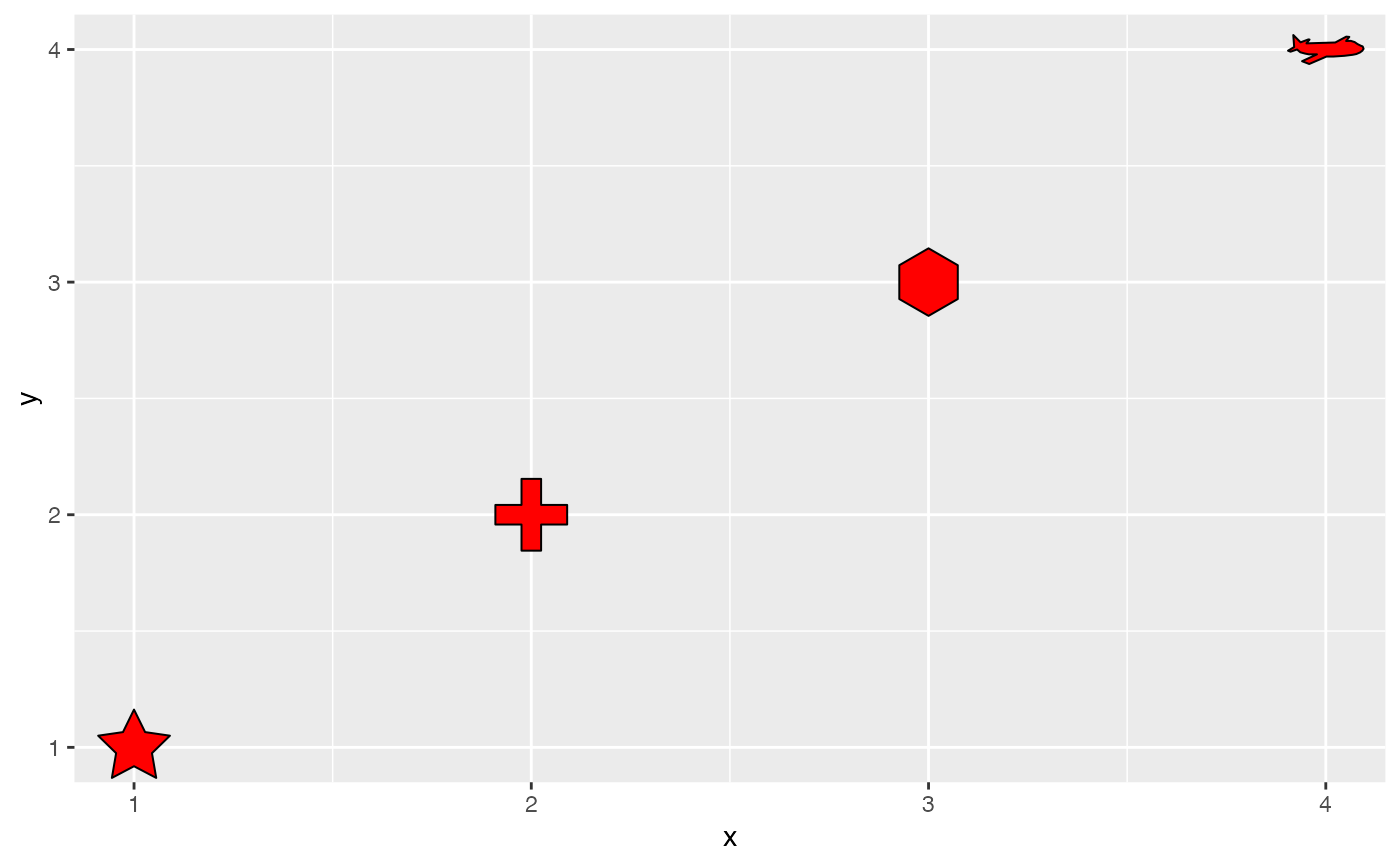Add polygon glyphs on scatter plot
geom_polygon_glyph.RdEach point glyph can be a polygon object.
We provide some common polygon coords in polygon_glyph. Also, users can
customize their own polygons.
geom_polygon_glyph(
mapping = NULL,
data = NULL,
stat = "identity",
position = "identity",
...,
polygon_x,
polygon_y,
linewidth = 1,
na.rm = FALSE,
show.legend = NA,
inherit.aes = TRUE
)Arguments
- mapping
Set of aesthetic mappings created by
aes(). If specified andinherit.aes = TRUE(the default), it is combined with the default mapping at the top level of the plot. You must supplymappingif there is no plot mapping.- data
The data to be displayed in this layer. There are three options:
If
NULL, the default, the data is inherited from the plot data as specified in the call toggplot().A
data.frame, or other object, will override the plot data. All objects will be fortified to produce a data frame. Seefortify()for which variables will be created.A
functionwill be called with a single argument, the plot data. The return value must be adata.frame, and will be used as the layer data. Afunctioncan be created from aformula(e.g.~ head(.x, 10)).- stat
The statistical transformation to use on the data for this layer, either as a
ggprotoGeomsubclass or as a string naming the stat stripped of thestat_prefix (e.g."count"rather than"stat_count")- position
Position adjustment, either as a string naming the adjustment (e.g.
"jitter"to useposition_jitter), or the result of a call to a position adjustment function. Use the latter if you need to change the settings of the adjustment.- ...
Other arguments passed on to
layer(). These are often aesthetics, used to set an aesthetic to a fixed value, likecolour = "red"orsize = 3. They may also be parameters to the paired geom/stat.- polygon_x
nested list of x-coordinates of polygons, one list element for each scatterplot point. If not provided, a point visual (
geom_point()) will be displayed.- polygon_y
nested list of y-coordinates of polygons, one list element for each scatterplot point. If not provided, a point visual (
geom_point()) will be displayed.- linewidth
line width of the "glyph" object
- na.rm
If
FALSE, the default, missing values are removed with a warning. IfTRUE, missing values are silently removed.- show.legend
logical. Should this layer be included in the legends?
NA, the default, includes if any aesthetics are mapped.FALSEnever includes, andTRUEalways includes. It can also be a named logical vector to finely select the aesthetics to display.- inherit.aes
If
FALSE, overrides the default aesthetics, rather than combining with them. This is most useful for helper functions that define both data and aesthetics and shouldn't inherit behaviour from the default plot specification, e.g.borders().
Value
a geom layer
Aesthetics
geom_..._glyph() understands the following aesthetics (required aesthetics are in bold):
x
y
alpha
colour
fill
group
size
linetype
shape
stroke
The size unit is cm
Note that the shape and stroke do not have real meanings unless the essential
argument polygon_x or polygon_y is missing.
If so, a point visual will be displayed with corresponding shape and stroke.
See also
Examples
# polygon glyph
p <- ggplot(data = data.frame(x = 1:4, y = 1:4),
mapping = aes(x = x, y = y)) +
geom_polygon_glyph(polygon_x = list(x_star, x_cross, x_hexagon, x_airplane),
polygon_y = list(y_star, y_cross, y_hexagon, y_airplane),
colour = 'black', fill = 'red')
p
 # the coords of each polygons can be achieved by calling function `ggplot_build`
build <- ggplot2::ggplot_build(p)
polygon_x <- build$data[[1]]$polygon_x
polygon_y <- build$data[[1]]$polygon_y
# the coords of each polygons can be achieved by calling function `ggplot_build`
build <- ggplot2::ggplot_build(p)
polygon_x <- build$data[[1]]$polygon_x
polygon_y <- build$data[[1]]$polygon_y